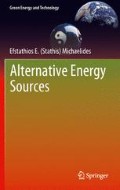Abstract
In the beginning of the twenty-first Century, our society mostly uses energy that has been accumulated for millennia: Fossil fuels have stored in their chemical compounds vast amounts of energy, which we now use for our primary energy needs, unfortunately, at a very high rate that cannot be sustained. When fossil-fuels are exhausted or when their use is curtailed because of environmental factors, such as the production of greenhouse gases, humans will have to rely more on alternative energy sources among which are nuclear, wind, and solar power. While the production of power by nuclear energy may be controlled, wind and solar power are intermittent or periodic sources, which may produce power when there is limited demand and may not produce power at all, when demand is high. For example, during the night hours of July 17th, when there is high demand for air-conditioning and electricity in the northern hemisphere, there is no Sun and the average wind power is significantly lower than average. If the society relies on alternative energy sources and stored energy is not available during this night, humans will experience a significant shortage of energy with the inconvenience this entails. As the human society moves more to the direction of alternative energy sources, the need for energy storage becomes apparent and more acute in order to satisfy the fluctuating energy demands. This chapter provides an exposition to the several energy storage methods that are currently used to smoothen the electric power demand and those that may become feasible and popular in the future. First, the electric energy demand patterns in a contemporary society that makes significant use of air-conditioning in the summer are explained. Secondly the various methods for energy storage, such as electromechanical, thermal—in both latent and sensible heat form—and chemical are explained with the devices/systems that make energy storage possible. The alternative method of storing “coolness” with materials that exhibit a temperature hysteresis in their melting/solidification processes is elucidated within the context of thermal storage methods. Finally, details are given on the possible switch to hydrogen as a clean energy storage medium, the long advocated “hydrogen economy” and the inherent advantages of Fuel Cells as devices for the direct conversion of chemical energy to electricity.
Access this chapter
Tax calculation will be finalised at checkout
Purchases are for personal use only
Notes
- 1.
During the storage mode, an exergy storage system is a closed system and for this reason, the expressions used for the exergy function are those pertinent to closed systems.
- 2.
Upon condensation the steam will release 2,257 kJ/kg and will become liquid water at 100oC.
- 3.
A low amount of electric power is still needed for the circulation of air.
- 4.
The same concept may be applied to the operation of the Daniel cells and all electrochemical devices.
- 5.
Most of the fuel cells operate at atmospheric pressure and for this reason the relevant properties ΔH o and ΔG o, which may be readily found in thermodynamic or chemical tables, are used here. In the rare case when the fuel cell operates at a different pressure, the relevant properties would be ΔH and ΔG, evaluated at the temperatures and pressures of the pertinent reactions.
References
EL‐Wakil MM (1984) Power Plant Technology, McGraw‐Hill, Newyork
Tester JW, Drake EM, Driscoll MJ, Golay MW, Peters WA (2005) Sustainable Energy: Choosing among options, MIT Press, Cambridge
Author information
Authors and Affiliations
Rights and permissions
Copyright information
© 2012 Springer-Verlag Berlin Heidelberg
About this chapter
Cite this chapter
(Stathis) Michaelides, E.E. (2012). Energy Storage. In: Alternative Energy Sources. Green Energy and Technology. Springer, Berlin, Heidelberg. https://doi.org/10.1007/978-3-642-20951-2_12
Download citation
DOI: https://doi.org/10.1007/978-3-642-20951-2_12
Published:
Publisher Name: Springer, Berlin, Heidelberg
Print ISBN: 978-3-642-20950-5
Online ISBN: 978-3-642-20951-2
eBook Packages: EngineeringEngineering (R0)

